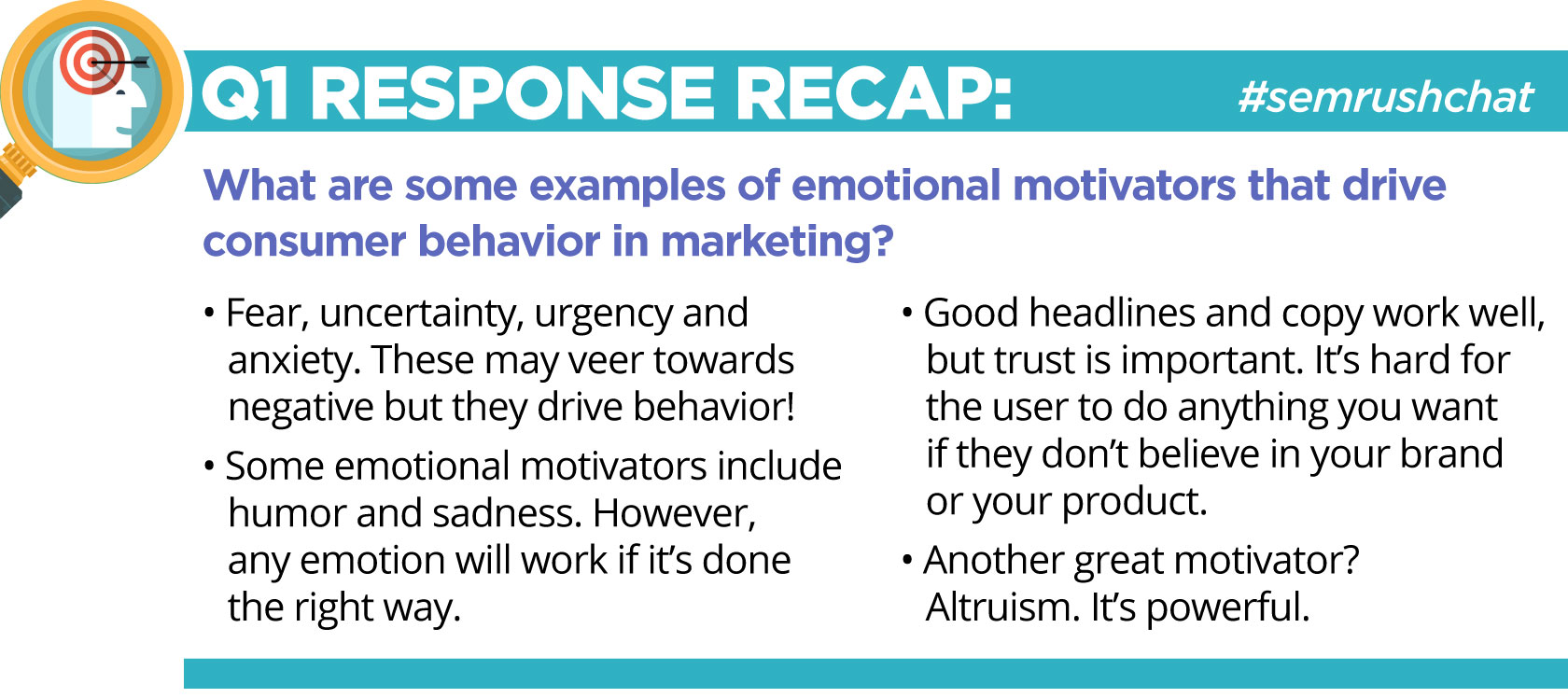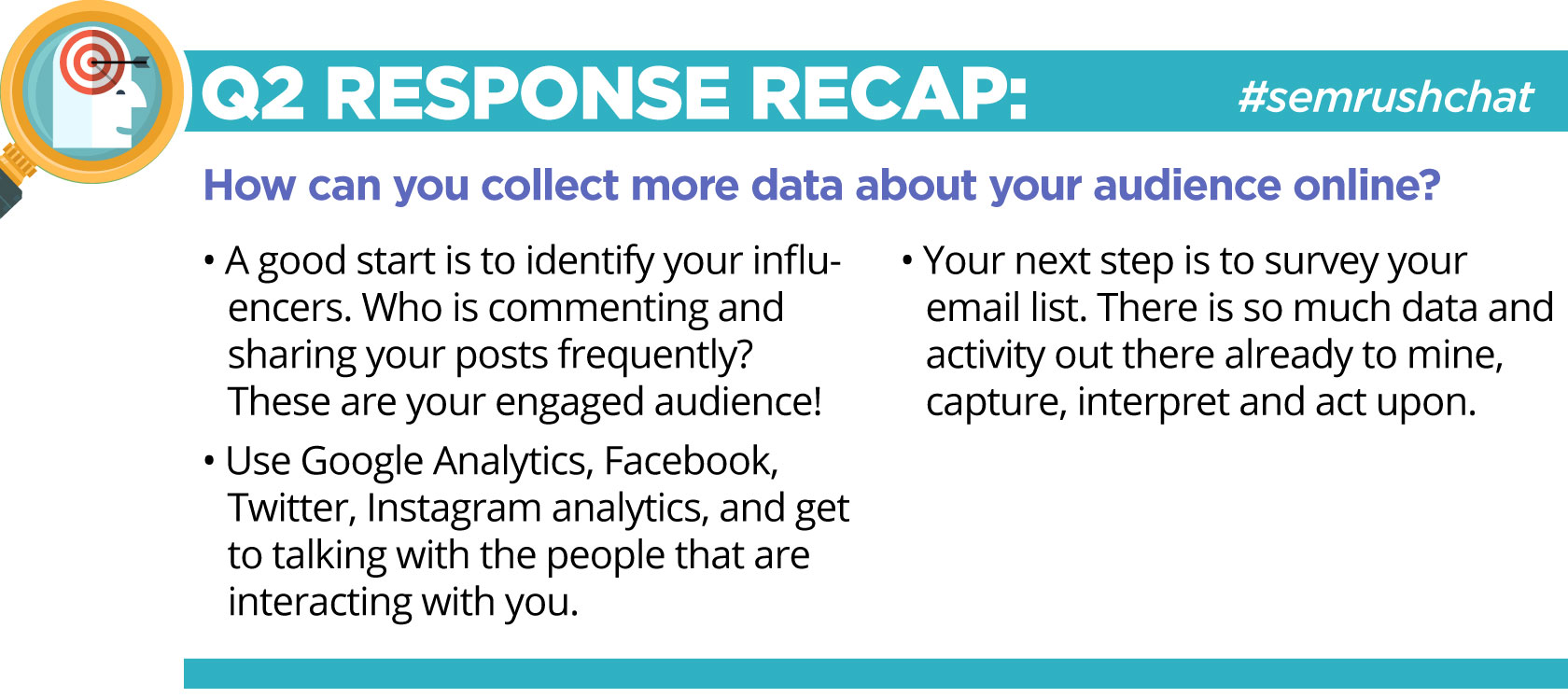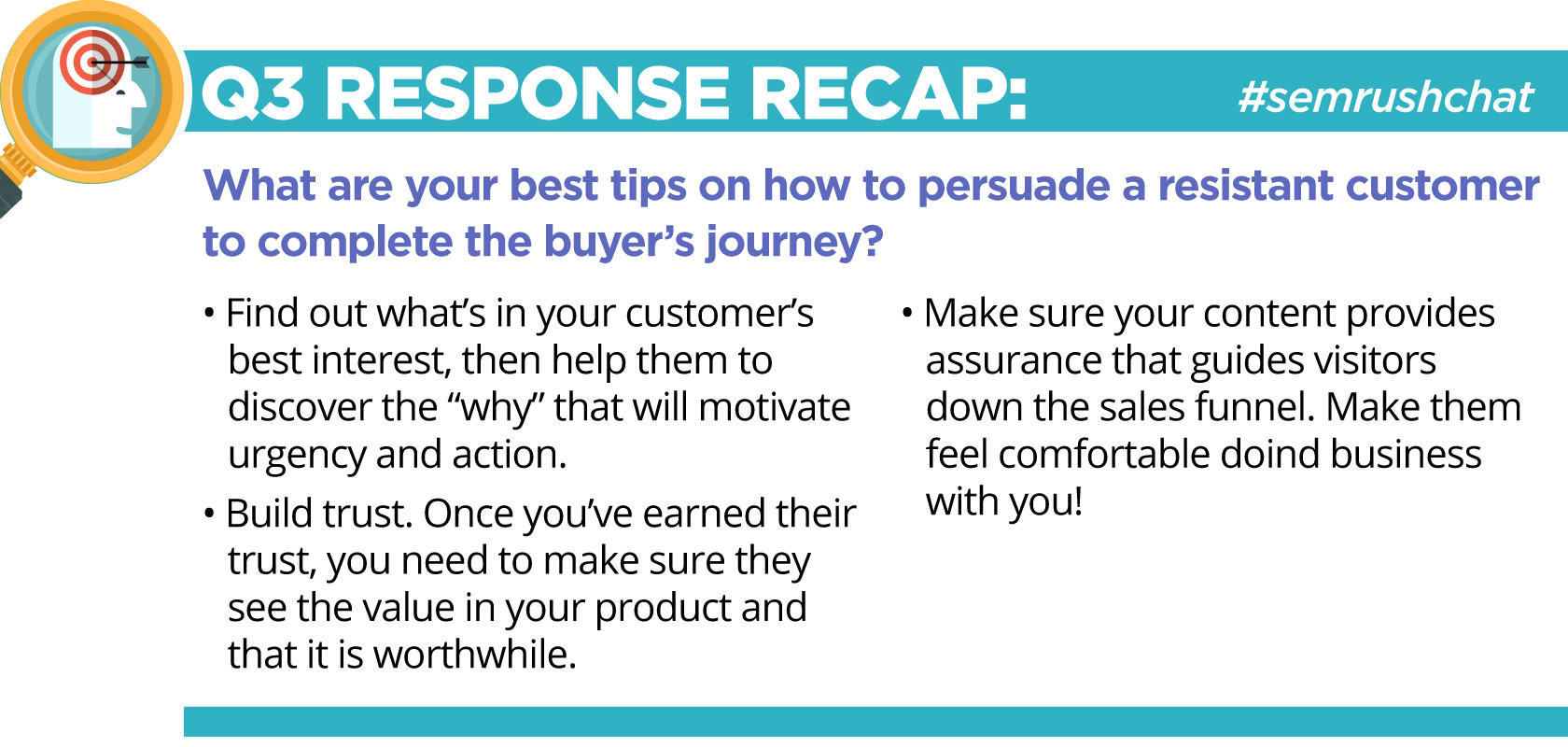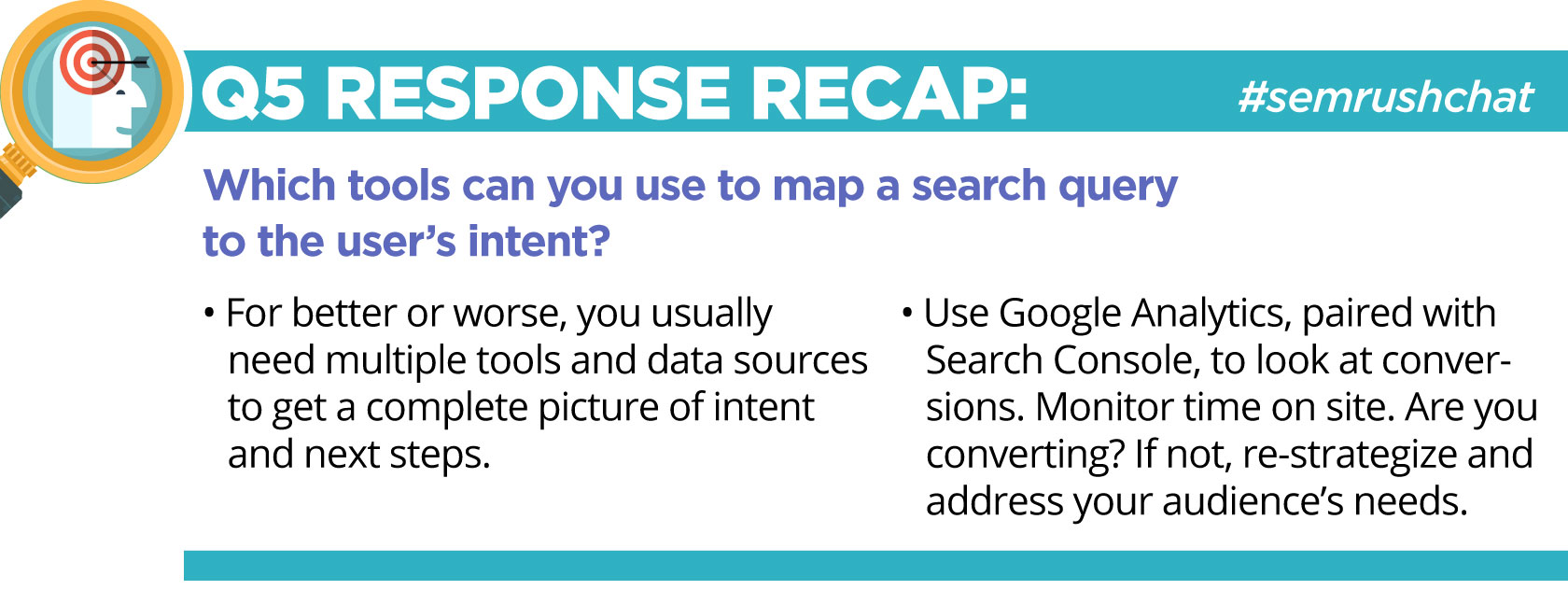Digital Psychology is a discipline that combines social sciences with digital best practices, and it looks at online behavior through the lens of psychology and behavioral economics. Andrew Nicholson describes the digital psychology approach by using the metaphor of a fisherman in waders in a river. In this analogy, the fisherman represents the human brain and the river represents technology that’s always changing and moving fast. The human brain remains the same for thousands of years, while technology is constantly changing.
The idea is that to better understand why people are acting the way they are, we need to start observing technology through a neurological aspect, rather than trying to influence the human brain from a technological perspective. The digital psychology approach is focused on understanding and explaining online user’s activity.
In our latest SEMrush Chat, we discussed digital psychology and how it can help marketers get into their customers’ minds. This time we were joined by Matt Heinz, President of Heinz Marketing, Host of Sales Pipeline Radio, keynote speaker, and author, as our special guest.
Check out the following chat recap to find out how to collect more data about your online audience, persuade your customer to complete the buyer’s journey, and much more!
Q1. What are some examples of emotional motivators that drive consumer behavior in marketing?
By nature, people are emotional creatures. Therefore, many companies use an emotional marketing approach to appeal to their consumers’ emotions and convince them to purchase specific products or services.
Here’s a list of several emotional triggers that marketers use to drive consumer behavior:
Fear, uncertainty, urgency, and anxiety
Matt Heinz named four basic emotional triggers that can help you craft more effective marketing messages and draw your audience’s attention - all of them being powerful emotions. For example, fear and urgency can produce quick reactions without conscious thoughts. Sometimes, you need make your customers take immediate actions and to do so, you should produce a sense of urgency. Debi Norton @BRAVOMedia1 provided an example: “Emotional Motivators — incentives that evoke urgency! Free Shipping, % off ONLY TODAY.”
These emotions are powerful triggers that effectively drive consumer behavior. However, Matt remarked that they may bring some negative reactions. Therefore, you need to use them carefully.
A1: Fear, uncertainty, urgency, anxiety - these may veer towards negative but they drive behavior for sure. #semrushchat
— Matt Heinz (@HeinzMarketing) March 15, 2017
Altruism
Another powerful emotional trigger that our guest expert mentioned is an altruistic trigger. Some consumers make purchases consciously. They care about social issues and they want to make sure that they're buying from companies that are socially responsible. For example, a well-known American manufacturer of ice cream and frozen yogurt created the Ben & Jerry’s Foundation that provides grants for social programs and encourages its employees to take part in social change work around the country. When its customers purchase their products, they know that they are directing their money towards a company that works to promote safe and socially responsible business practices and ingredients.
A1: Altruism as well is often overlooked but a powerful motivator #semrushchat
— Matt Heinz (@HeinzMarketing) March 15, 2017
A sense of belonging
Human beings have a strong desire to belong to something; whether it’s a family, a group, a clan, or a social network. Creating a feeling of belonging with your customers satisfies their core psychological needs and wants. Therefore, some companies aim their efforts at building strong brand communities to let their clients feel as if they belong to something and can contribute. People like to feel a “Sense of belonging, safety, security, success, personal development, self-confidence, and adventure” tweeted Ryan Joos @RyanJoos.
A1) A feeling of belonging caused by community or empowerment to guide brand decisions. #semrushchat
— Ryan Johnson (@rsj8000) March 15, 2017
Triggers that inspire curiosity
Human curiosity not only inspires action, but it can also increase activity in the parts of the brain areas that is associated with reward. If you trigger people’s curiosity, you’ll be able to convince your prospects to open your emails, read then promote your content, and finally, buy your product or service.
To find out more, you can read this article by Derek Halpern on how to write a blog post that can intrigue your audience.
@semrush A1 Touch their desires with messages that induce want or interest. Touch intrinsic benefits, and appear unique. #semrushchat
— Steve Hill (ステブ ヒル) (@epiclysteve) March 15, 2017
Trust
If people don’t trust you, it will be much more difficult for you to turn them into your paying customers. To make people buy from you, you need to persuade them that you are a reputable and trustworthy business.
“You need trust most of all, and it helps if you write your copy in a way that draws attention, such as a shock factor,” tweeted Annaliese Henwood @MktgInnovator. You must demonstrate that you can be trusted.
A1: Trust. It's hard for the user to do anything you want if they don't believe in your brand or your product. #semrushchat pic.twitter.com/SaEibxPkYG
— Joe Martinez (@MilwaukeePPC) March 15, 2017
Let’s sum up!

Whichever emotional triggers you use, you can get creative with them. You need to think about your clients and what their needs, wants and beliefs are. Try to connect with your audience through emotions and create your story based on it.
Q2: How can you collect more data about your audience online?
Do you know who your target market is? Knowing your audience includes multiple elements, such as problems that your audience faces, things they trust and distrust and what they love and hate. If you’re not sure how to answer these questions, it might be useful for your company to go a step further by getting to know your clients better.
Our chat guests shared their tips for collecting more data about your audience:
Keep track of actions and buying signals
Our special guest recommended tracking your customer's actions and specific buying signals. Pay attention to what they do in order to understand their next steps.
When it comes to buying signals, we usually think about body language or specific types of questions your potential clients ask. Online signals are a bit different, but have the same idea with the offline buying indicators.
For example, email interactions, including opening your emails or clicking a link, show that a person is interested in your business and what you have to say. To do so, you can try out some helpful tools, such as Google Analytics, Yesware, and ToutApp. People who visit your pricing page strongly indicate that a user is considering buying from you. They may be interested in your offer, but they're still looking for more information.
A2: Track actions & look for buying signals: what are your customers doing & what does that imply about what they need next? #semrushchat
— Matt Heinz (@HeinzMarketing) March 15, 2017
Identify influencers
People tend to listen to recommendations from reliable sources that they trust. A positive review from an influencer in your niche can significantly expand your brand’s reach and increase your credibility in your industry. That’s why collaborating with an influencer can help you to get your message in front of the right audience.
You need to discover who is commenting on your posts and sharing them and then research those people’s profiles. It will help you find out influencers that your audience listens to. Follow them, find as much as possible about them, take part in conversations that are relevant to your topic, and try to build long-term relationships with them by bringing value to your partnership.
A2) Identify influencers. Who is commenting/sharing your posts frequently? This is engaged audience - look at their profiles #semrushchat
— Ryan Johnson (@rsj8000) March 15, 2017
Conduct surveys
To learn more about your audience, you need to conduct regular surveys, which is a powerful tool to discover the thoughts and opinions of your online community. You can use both quantitative and qualitative surveys. The former gives you understanding about your audience’s habits and shows you if the assumptions you made are correct. Use questions with multiple choice.
With the qualitative survey, on the other hand, you’ll be able to earn more detailed information about your audience’s makeup. It’s worth using open-ended questions in order to get long responses that you can analyze and interpret.
@semrush A2: Tools like Google Analytics and @Lexalytics but also there's the old fashion asking; surveys, polls, h2h, etc #semrushchat pic.twitter.com/1MMeLCKtuF
— Chris Santiago (@Chris_Santiago_) March 15, 2017
Provide an incentive
When it comes to surveys, you can encourage your site visitors to complete your survey by giving them something valuable in return. Pat Whalen suggested providing an incentive that will make your survey more attractive. It can be a discount, a free trial, or a coupon.
A2: Provide incentive. Give a survey with a prize attached #semrushchat pic.twitter.com/KYoM60ZQgR
— Pat Whalen (@2patwhalen) March 15, 2017
Listen to and talk with your audience
There’re so many sources where you can “listen” to your target audience, such as social media networks, blogs, and question-and-answer websites like Quora. Check out what people in your industry are talking about, then talk with them, not at them. You need to make sure that you have a mutual conversation with your audience. Ask them questions to figure out what they really need. “If you want to collect more data about your audience, talk to them. You can learn so much by having a conversation,” tweeted Express Writers @ExpWriters.
A2: Surveys, Google Analytics, FB/Twitter/Instagram Analytics, and get to talking with the people that are interacting with you #semrushchat
— Roslyn Wertheimer ? (@RE_Wertheimer) March 15, 2017
As Matt Heinz said, there is so much data and activity on the Internet to mine, interpret and act upon. You just need to find the best ways to capture insights into your users’ minds and use it properly.

The more data you can collect from your audience, the more value you will deliver to them. Use the tips from our chat guests to better understand your customers.
Q3. What are your best tips on how to persuade a resistant customer to complete the buyer’s journey?
The buyer’s journey is a critical element to any marketing strategy. The most commonly used version of it includes three stages: awareness, consideration, and decision.
First of all, you need to have a clear understanding of your audience in order to define your business’ buyer’s journey and persuade your prospects to move through it. We’ve already discussed how to get more information about your audience. “First, you've got to know your audience — who they are, where they are, why they're there and how they convert,” tweeted ThinkSEM @ThinkSEM.
Now, let’s find our other tactics to convince your customer to complete your company’s buyer’s journey.
Find out what may interest your customers
Every company needs to have a clear reason for its customers to purchase its products or services. Why should people buy from you and not your competitors? By answering this question, you can define your unique selling proposition (USP).
The digital world is highly competitive. Unless you can point out what makes your brand unique and how your product or service can interest your audience, you cannot target them effectively. “You aren't going to push prospects where they don't want to go,” pointed out Matt Heinz.
A3: Find what's in their best interest, help them discover the "why" that will motivate urgency and action #semrushchat
— Matt Heinz (@HeinzMarketing) March 15, 2017
Understand what prevents them from completing the buyer’s journey
A few of our chat participants suggested figuring out what may prevent your site visitors from completing your buyer’s journey. Make sure that your site’s content is focused on your clients’ pain points, that all important information about your brand is available, and that your site has a clear call to action that explains what your users need to do and what they can get from buying your product or service.
A3: Know where in the cycle they're "sticking." WHY are they not progressing? Need to know their hangup before fixing it... #semrushchat https://t.co/yJ5CelOHSn
— ThinkSEM (@ThinkSEM) March 15, 2017
@semrush A3. Identify unarticulated reasons they might be stuck & provide value, help, without pushing the sale. #semrushchat pic.twitter.com/9ss2Ss2ZLb
— Chris Santiago (@Chris_Santiago_) March 15, 2017
Make sure every important question is answered
Today’s users have very little patience and very high expectations. They want information and they want it fast. If your website's visitors don’t get what they need fast enough, they will leave your site and move on to your competitors. You need to prove your customers that you’re the best at what you do. Also, Joe Martinez remarked that your users must understand that your brand can be trusted.
A3: My A1 answer of trust. But also making sure every, important question is answered. Leave no doubt. Prove you're the best. #semrushchat
— Joe Martinez (@MilwaukeePPC) March 15, 2017
Be responsive and accessible
The ability to be more responsive and accessible to your customers and their needs is becoming an increasingly important advantage. If your clients have questions, you need to be there to provide answers to them as soon as possible. Listen to your audience and try to understand what they really need, improve and speed up your decision making process.
Praveen Sharma @i_praveensharma recommended having a Live Chat on your website. Having questions answered by a live person during an online purchase process can be a very powerful tool, as many people prefer to deal with real people, rather than bots.
A3: Be responsive! Sometimes customers have questions and if you don't answer them, you'll lose them! #semrushchat
— Lauren Scarpa (@LScarpa22) March 15, 2017
Pay attention to UX
Traffic Jam Media believes that instead of persuading your prospects, you need to listen to them carefully and pay considerable attention to user experience on your website. You need to apply those insights that you collected about your audience to create relevant and engaging interactions that will help your site visitors easily complete your buyer’s journey.
A3: There shouldn't be any persuading. Listen to your customers & look at UX! If your product is good, the journey needs work. #semrushchat
— Traffic Jam Media (@trafficjammedia) March 15, 2017
You can check out a few other answers in the following recap.

Make sure that you have appropriate paths for your website visitors to follow, answer all their questions, and move them forward in the buying cycle.
Q4. How can you gather the best information to find the right people through the right channel?
Understanding your customer is notrocket science, but it requires an in-depth analysis of where and how you can collect this important information. You need to match appropriate methods of communication with each audience.
Many of our chat participants believe that your first step should be gaining a clear understanding of who your users are, which includes information about on and offline places that they spend their time and how they convert.
A4: First you've got to know your audience--who they are, WHERE they are, WHY they're there & how they convert.
Easy peasy. #semrushchat https://t.co/rVklGgzngX
— ThinkSEM (@ThinkSEM) March 15, 2017
You can get useful information about your customers through social media and specific metrics like engagement and conversions.
@semrush A4. Get to know your audience, genuine community; harvest stories from data - engagement, social, conversions, etc. #semrushchat
— Chris Santiago (@Chris_Santiago_) March 15, 2017
Traffic Jam Media remarked that it’s important to think of your target audience when choosing channels to communicate with them on. Some marketers make the mistake of choosing a channel first, then hoping to get information they are looking for. That usually doesn't work.
Not all customers are created equally and different businesses have different types of audiences. When you understand how your potential clients behave and what key factors set them apart from other users, you’ll be able to choose the right communication channel and better target your message.
A4: You need to think about your target audience when choosing your channels - not hope for info after you have channels! #semrushchat
— Traffic Jam Media (@trafficjammedia) March 15, 2017
Debi Norton pointed out the importance of knowing your ideal target audience and then to work backwards. Try to answer the question about who would benefit from your product and service and then go after that target user. One of the advantages of this approach is that it can help you to find out in the process that the audience you initially chose may not be your ideal customer. You may realize that your product or service is perfect for another audience that you didn’t try to reach to before.
@semrush a4 Know the ideal target audience then work backward from there. #semrushchat
— Debi Norton (@BRAVOMedia1) March 15, 2017
The following method can be costly, but will pay off by providing your company with wealth of information about your prospects. To nurture online discussion and communication with your audience, you can run an online focus group or a survey to collect information about your ideal customer and reach out to them.
A4: If you have the time and $$ create online focus groups, use surveys to gather and reach out to create your ideal persona. #semrushchat
— Danny Ray Lima (@dannyraylima) March 15, 2017
Some of our chat guests also recommended participating in Twitter chats and join in on discussions in niche Facebook Groups to better connect with your audience.
. @semrush A4: Participate in twitter chats and in discussions of niche dedicated Facebook groups. Connect with members. #semrushchat
— RankWatch (@RankWatch) March 15, 2017
Let’s sum up these key points:

Collecting information about your audience enables you to develop a highly targeted marketing campaign and create a message that will be relevant and interesting to your users.
Q5. Which tools can you use to map a search query to the user’s intent?
At the end of our discussion, our chat guests shared a few tools that helps you to better map a search query to the user’s intent.
Most of our chat participants named Google Search Console. “Google Analytics, paired with Search Console, to look at conversions. We also love that AdWords gives all query data,” tweeted the ThinkSEM team.
For search engine advertising (SEA), Fanny Heuck recommended using the search term report in Google AdWords and paid tools.
A5: Wow - tons! For organic search: I use Google Search Console, For SEA: Keyword search report or paid tool, like semrush, etc #semrushchat
— Fanny Heuck (@FannyHeuck) March 15, 2017
Viable Operations pointed out that Google Analytics provides you with essential analytical data. This service helps you determine which online campaigns bring the most traffic and conversions, where your site visitors are located, your most visited pages, what people are searching on your site, and what they click on the most, just to name a few.
A5: The G analytics & others can determine if your pages are even being looked at, don't discount past cx & that data either??? #semrushchat
— Viable Operations (@viabledigital) March 15, 2017
You can also try out other tools, such as Twitter Analytics, Facebook Insights, and Instagram Insights.
A5: Use Google analytics to look at referrals as well as Twitter analytics, Facebook/ IG insights etc. #semrushchat
— Traffic Jam Media (@trafficjammedia) March 15, 2017
Finally, Matt Heinz remarked that to successfully map a search query to the user’s intent, it’s worth using multiple tools and combining data sources to get a complete picture of the user’s intent.
A5: For better or worse, you usually need multiple tools & data sources to get a complete picture of intent & next steps #semrushchat
— Matt Heinz (@HeinzMarketing) March 15, 2017
Let’s sum up!

That’s it for today!
Digital psychology can help marketers to understand why their customers buy or don’t buy products and services online, how to retain your resistant users, and influence their decisions online.
We would like to thank Matt Heinz and our other chat guests for sharing their tips and expertise!
Innovative SEO services
SEO is a patience game; no secret there. We`ll work with you to develop a Search strategy focused on producing increased traffic rankings in as early as 3-months.
A proven Allinclusive. SEO services for measuring, executing, and optimizing for Search Engine success. We say what we do and do what we say.
Our company as Semrush Agency Partner has designed a search engine optimization service that is both ethical and result-driven. We use the latest tools, strategies, and trends to help you move up in the search engines for the right keywords to get noticed by the right audience.
Today, you can schedule a Discovery call with us about your company needs.
Source:




![How To Create a Strategic Dashboard in Excel Using Semrush Data [Excel Template Included]](https://allinclusive.agency/uploads/images/how-to-create-a-strategic-dashboard-in-excel-using-semrush-data-excel-template-included.svg)
